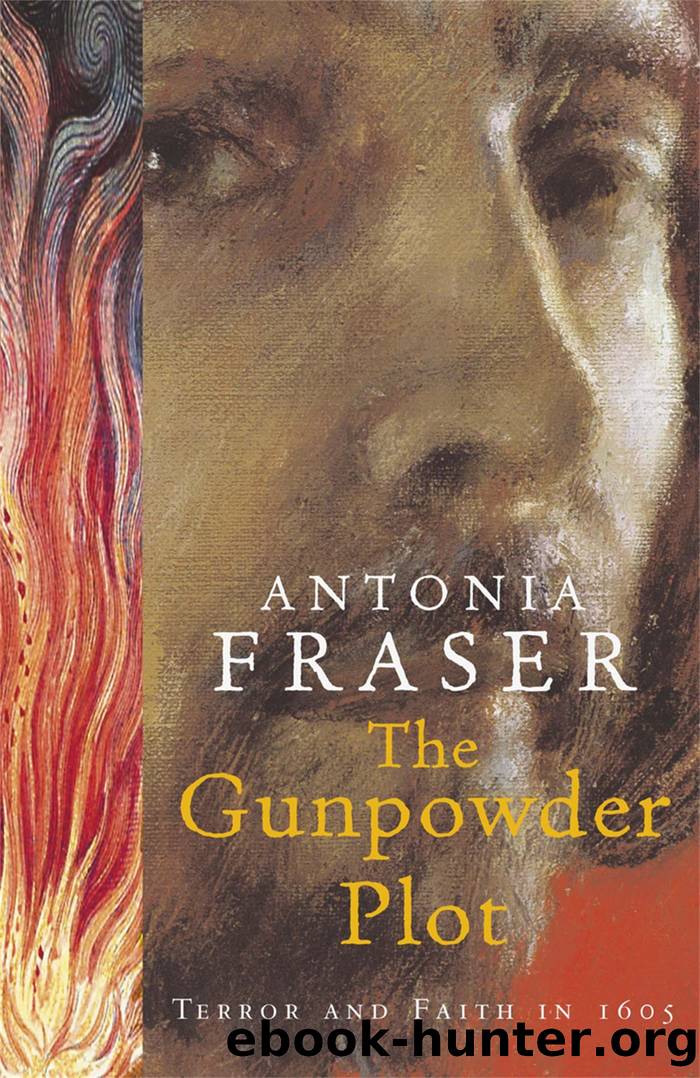The Gunpowder Plot: Terror and Faith in 1605 by Fraser Antonia

Author:Fraser, Antonia [Fraser, Antonia]
Language: eng
Format: epub
Tags: History, Religion, Politics, Biography
ISBN: 9780297857938
Amazon: B0050C85JQ
Goodreads: 11859118
Publisher: Phoenix
Published: 1996-08-27T07:00:00+00:00
CHAPTER TWELVE
The Gentler Tortures
The gentler tortures are to be first used unto him [Guy Fawkes]â¦
â¦and so God speed your good work. â James R
LETTER OF KING JAMES I
6 November 1605
The decision to apply torture to âJohn Johnsonâ was taken by the King on 6 November. Throughout the day the veteran Lord Chief Justice Sir John Popham pursued his investigations. Now in his mid-seventies, Popham was âa huge, heavy, ugly manâ. He was also implacable and âinordinately cruelâ in his hatred of the Catholics. His main line of attack was to go for those known Catholic subversives who had precipitately vanished from their usual haunts. Thus the servants of the extravagant, showy Ambrose Rookwood were examined on this day and his goods at Clopton â those incriminating crucifixes, beads and vestments â were seized.1
It is of course impossible to be certain how much of this process was helped on by Treshamâs confidences to Monteagle, which were relayed forward. By the evening, however, the Lord Chief Justice had discovered enough to tell Salisbury that in addition to Percy he had âpregnant suspicion⦠concerning Robert Catesby, Ambrose Rookwood, one Keyes, Thomas Wynter [sic], John Wright and Christopher Wright and some suspicion of one Grantâ.2 Apart from Tresham, it will be seen that three names were missing at this stage: Digby, Robert Wintour and Bates. The omission of Bates may be due to his inferior status, which made him less immediately interesting to the government. But the omission of Digby and Robert Wintour, both of whom operated in the midlands, suggests that the original source may well have been Francis Tresham, who from his London base would not necessarily have known of their involvement.
For all these advances, the obduracy of âJohn Johnsonâ continued to enrage and baffle the authorities. Who on earth was he, with his scarred body and his mysterious past? Catholic subversives were supposed to be known to the government and closely watched, in an England which in its supervisory aspects met the criteria of a modern police state. But Guido stoutly maintained his false identity, allowing his comrades, as he hoped â if only it had been true! â time to get clear of the country.
Guido was now transferred to the Tower of London. The King himself drew up a list of questions that were to be put to him there, headed by the vital question âas to what he is, For I can never yet hear of any man that knows himâ. After that, there followed many others including âWhen and where he learned to speak French?â and âIf he was a Papist, who brought him up in it?â (There was evidently a strong suspicion that this âJohn Johnsonâ was a Catholic priest.)3
The decision to put Guido to the torture was one that needed the authority either of the King or of the Privy Council, using the royal prerogative. King James himself took an active interest in the whole topic and his rights of decision in the matter. When Ralegh
Download
This site does not store any files on its server. We only index and link to content provided by other sites. Please contact the content providers to delete copyright contents if any and email us, we'll remove relevant links or contents immediately.
The Lost Art of Listening by Michael P. Nichols(7453)
Why I Am Not A Calvinist by Dr. Peter S. Ruckman(4125)
The Rosicrucians by Christopher McIntosh(3491)
Wicca: a guide for the solitary practitioner by Scott Cunningham(3149)
Signature in the Cell: DNA and the Evidence for Intelligent Design by Stephen C. Meyer(3098)
Real Sex by Lauren F. Winner(2986)
The Holy Spirit by Billy Graham(2914)
To Light a Sacred Flame by Silver RavenWolf(2787)
The End of Faith by Sam Harris(2705)
The Gnostic Gospels by Pagels Elaine(2495)
Waking Up by Sam Harris(2421)
Nine Parts of Desire by Geraldine Brooks(2343)
Jesus by Paul Johnson(2330)
Devil, The by Almond Philip C(2303)
The God delusion by Richard Dawkins(2284)
Heavens on Earth by Michael Shermer(2256)
Kundalini by Gopi Krishna(2151)
Chosen by God by R. C. Sproul(2142)
The Nature of Consciousness by Rupert Spira(2069)
